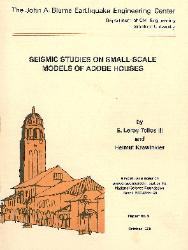






































































ELT & Associates
Seismic Engineering of Earthen Buildings
Serving California and the World Since 1984
Serving California and the World Since 1984
Telephone: (510) 295-4299
Doctoral Research & Thesis
writing of his doctoral thesis: SEISMIC STUDIES ON SMALL-SCALE Dr.
Tolles spend over seven years doing the basic research, analysis and
MODELS OF ADOBE HOUSES. The primary goals of this research were to
evaluate the seismic performance of adobe buildings and determine the
effectiveness of very simple seismic improvement measures.
The most common conceptual framework used to understand the seismic
behavior of buildings during earthquakes is based on a static force equivalent
to replicate dynamic earthquake forces. Based upon this conceptual
framework, adobe buildings have little residual capacity once cracks have
occurred and the buildings should collapse shortly after cracks have fully
developed.
For thick-walled adobe buildings, nothing could be further from the truth.
The interesting portion of an adobe buildings performance is only just
beginning at the time when cracks have fully developed.
Adobe buildings have thicker walls that almost any other masonry building
type. The walls typically have height-to-thickness (slenderness) ratios of 5 or
6 whereas common brick buildings have slenderness ratios of 10-15. A thin
brick wall will overturn easily but it is much harder to de-stabilize a thick
adobe wall and modest efforts to improve the out-of-plane stability can make
dramatic improvements for the seismic behavior of these adobe buildings.
The focus of Dr. Tolles’ research was towards application to rural housing in
developing countries. Since adobe buildings are most commonly used in areas
were money is scarce, the retrofit measures needed to be simple and cost-
effective but must also be structurally effective.
Tolles spend over seven years doing the basic research, analysis and
MODELS OF ADOBE HOUSES. The primary goals of this research were to
evaluate the seismic performance of adobe buildings and determine the
effectiveness of very simple seismic improvement measures.
The most common conceptual framework used to understand the seismic
behavior of buildings during earthquakes is based on a static force equivalent
to replicate dynamic earthquake forces. Based upon this conceptual
framework, adobe buildings have little residual capacity once cracks have
occurred and the buildings should collapse shortly after cracks have fully
developed.
For thick-walled adobe buildings, nothing could be further from the truth.
The interesting portion of an adobe buildings performance is only just
beginning at the time when cracks have fully developed.
Adobe buildings have thicker walls that almost any other masonry building
type. The walls typically have height-to-thickness (slenderness) ratios of 5 or
6 whereas common brick buildings have slenderness ratios of 10-15. A thin
brick wall will overturn easily but it is much harder to de-stabilize a thick
adobe wall and modest efforts to improve the out-of-plane stability can make
dramatic improvements for the seismic behavior of these adobe buildings.
The focus of Dr. Tolles’ research was towards application to rural housing in
developing countries. Since adobe buildings are most commonly used in areas
were money is scarce, the retrofit measures needed to be simple and cost-
effective but must also be structurally effective.











